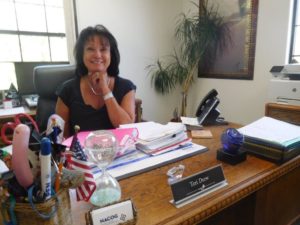As many as 42 million citizens may not have access to high-speed internet.
“The intensity for creating broadband awareness has prompted us with NACOG to sponsor a major survey throughout Yavapai, Coconino, Apache and Navajo Counties. That survey will help us develop a strategic blueprint for improving connectivity and digital equity among our citizens,” she explained.
Drew defined broadband infrastructure as the cabling and electrical systems that wire homes and businesses into local and regional telecommunication and cable companies. “Communications networks and the internet are linked together, making it possible to interconnect local users with internet, telephone, television and other similar services.”
Bandwidth describes how much information can be transmitted in a network. “The more bandwidth, the fewer bottlenecks to slow the flow of information,” she said.
Drew and her NACOG colleagues with the Economic and Workforce Development program have partnered with Magellan Advisors, an industry-leading broadband company, to assess broadband availability in the four counties that comprise NACOG.
“Our primary goal is to gather information from residents and organizations within our various communities – large and small – so we can better understand their unique needs. To do that, we’re asking residents and businesses in all the communities to participate by taking what we have called the ‘NACOG Broadband Survey,’” she said. “It takes about 10 to 15 minutes. It should be completed by the person in your residence or organization who chooses or uses and pays for services in that location.”
Julia Sawyer, Drew’s executive assistant, emphasized that data collected during surveys will not be used for any purpose other than developing the strategic plan. “If a person feels uncomfortable with a question, that question can be skipped. All we want is to gather demographic and statistical data so that we can compare information with census data and interpret the statistical relevance of responses. Privacy is absolutely assured.”
Participating in the survey will continue until probably the end of June, Sawyer said. The survey is totally online, so only those with access to the internet can participate.
Once survey data has been compiled, NACOG hopes to apply for state and federal grants, examine current and future infrastructure needs in the region, identify unserved and underserved areas, conduct a needs assessment, look for public-private partnership opportunities and design conceptional networks.
Part of a Bigger Scheme
What is happening in NACOG and the other regions in Arizona is part of a national effort. A recent announcement from the Federal Communications Commission indicates the FCC plans to provide low-income households across the nation with assistance to help them cover internet costs.
A $3.2 billion Emergency Broadband Benefit (EBB) is available to households that participate in existing low income and pandemic relief programs offered by high-speed internet providers. The same is true of subscribers to the FCC Lifeline Program. That includes those who receive Supplemental Security Income (SSI) benefits, Medicaid and support from the Supplemental Nutrition Assistance Program (SNAP).
A Pew Research Center study found that 53% of Americans believe the internet has been an essential tool during the pandemic. However, as many as 42 million citizens may not have access to high-speed internet.
NACOG is one of several organizations trying to help people by getting them connected, especially in rural areas. But the NACOG territory is diverse – from the northeastern borders of the state to Central Arizona. Officials say with nearly 48,000 square miles and 561,000 people, the use of broadband has become critically important.
“We are committed to the economic recovery and resilience of Northern Arizona. Please help us, through this survey, continue to be a vital resource to community resources, elder care, childcare, mobility and transportation planning and, certainly, economic and workforce development,” said Drew. QCBN
By Ray Newton, QCBN
For more information, call 928-778-1422 or visit nacog.org.






Leave a Reply